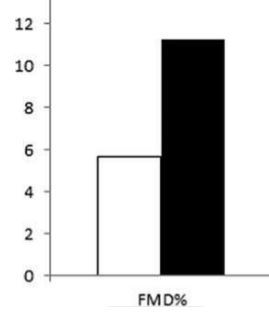Hemodialysis patients (CKD) helped by weekly 50,000 IU of vitamin D
Effect of vitamin D supplementation on endothelial dysfunction in hemodialysis patients.
Hemodial Int. 2017 Jan;21(1):97-106. doi: 10.1111/hdi.12439. Epub 2016 Jun 29.
📄 Download the PDF from VitaminDWiki
Karakas Y1, Sahin G2, Urfali FE3, Bal C4, Degirmenci NA3, Sirmagul B5.
1 Department of Medical Oncology, Cancer Institute, Hacettepe University, Ankara, Turkey.
2 Department of Nephrology, School of Medicine, Osmangazi University, Eskisehir, Turkey.
3 Department of Radiology, School of Medicine, Osmangazi University, Eskisehir, Turkey.
4 Department of Biostatistics, School of Medicine, Osmangazi University, Eskisehir, Turkey.
5 Department of Pharmacology, School of Medicine, Osmangazi University, Eskisehir, Turkey.
% Flow-mediated dilatation (% increase in arterial diameter)
 black = after 50,000 IU weekly
black = after 50,000 IU weekly
INTRODUCTION:
Patients with chronic kidney disease (CKD) commonly experience 25-hydroxyvitamin D3 (25-OH-D3) deficiency, and these patients have a higher incidence of cardiovascular diseases (CVDs) due to endothelial dysfunction (ED). The aim of our study was to investigate the effect of 25-OH-D3 deficiency and its supplementation on ED in patients with CKD.
METHODS:
Twenty-nine uremic patients on dialysis and 20 healthy controls were evaluated for ED by high-resolution Doppler ultrasonography of the brachial artery. In addition, 25-OH-D3-deficient patients (25-OH-D3 < 30 nmol/L) with CKD and healthy controls were evaluated for ED before and after 8 weeks of oral vitamin D (cholecalciferol, 50,000 units) treatment. All subjects were evaluated for percent flow-mediated dilatation (%FMD), percent endothelium-independent nitroglycerin-induced vasodilatation (%NID), and bilateral carotid intima-media thickness (CIMT).
FINDINGS:
Patients on dialysis had lower %FMD and %NID 6.11 [2.27-12.74] and 10.96 [5.43-16.4], respectively, than controls 15.84 [8.19-22.49] and 21.74 [12.49-29.4], respectively (P < 0.05). Patients on dialysis had higher left and right CIMT (0.79 ± 0.15 and 0.78 ± 0.14, respectively) than controls (0.60 ± 0.09 and 0.59 ± 0.09, respectively; P < 0.05). In 25-OH-D3-deficient patients with CKD, after vitamin D treatment, %FMD was significantly increased in dialysis patients (10.25 [7.8-12.8]) compared to before supplementation (5.4 [2.77-6.15]; P < 0.001).
DISCUSSION:
These results indicated that dialysis patients had significantly lower blood 25-OH-D3 levels and higher CIMT than healthy subjects. In addition, vitamin D supplementation improved ED and increased %FMD in dialysis patients. Our findings suggest that vitamin D supplementation in dialysis patients might prevent CKD.
